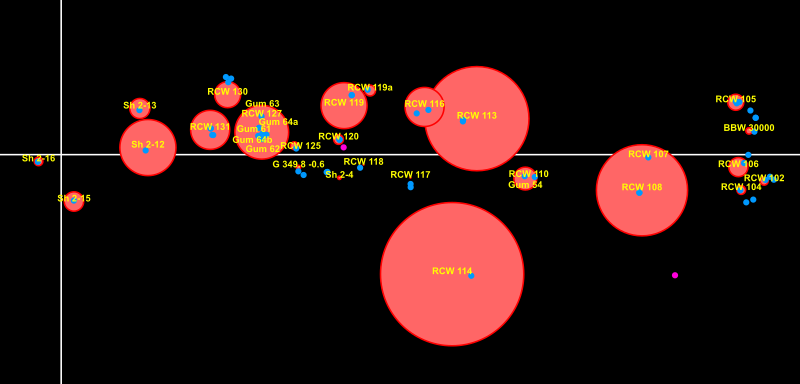
A detail from the catalog of ionizing stars for HII regions. A full all sky image in galactic coordinates is available here.
In 1984, Avedisova and Kondratenko published an important paper Exciting stars and the distances of the diffuse nebulae [ADS link: 1984NInfo..56...59A] in which they listed several hundred ionizing stars for HII regions.
Although the paper is written in Russian, the tables are provided in Roman characters.
Over the last few years I have expanded the Avedisova ionizing star catalog to include data from about 90 other scientific papers as part of a project to determine the ionizing stars for the major visible HII regions. I am making this expanded catalog available today in preparation for the Gaia DR2 release (expected in just a few hours now!). It contains more than 500 stars.
You can download the ionizing star catalog as a zip here. The catalog includes a reference to the scientific paper for each star, a SIMBAD identifier, the HII region it ionizes and, crucially, a cross match identifier for 2MASS or Tycho-2 so that parallaxes can be retrieved via the Gaia DR2 cross match tables.
In addition, the zip includes a table giving basic parameters for each HII region, including the galactic longitude and latitude, and the radius of the region in the sky in arcminutes.
Interestingly, the Avedisova catalog of ionizing stars was finished in the same year (1984) as the Humphreys/Blaha catalog of luminous stars I mentioned in my last blog post. This may not be entirely a coincidence. In some ways these catalogs were a culmination of a period from about 1970 to 1985 when astronomers were intensely interested in mapping optically visible objects in the Milky Way. After 1985, interest moved to non-visual frequencies and more astrophysical topics like dark matter or the age of the universe.
It seems clear that the release of Gaia DR2 today is likely to spark a new period of interest in mapping the Milky Way, making the Avedisova and Humphreys/Blaha catalogs very relevant again.
If you are interested in learning more about luminous stars or HII regions, please read The Cloud Hunters and The Star Sweepers for more information.
